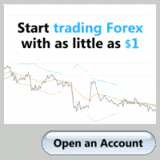If you have ever wondered what distinguishes successful traders from unsuccessfull traders, you are not alone. The industry figure commonly quoted is that 95% of traders lose some or all of there funds and quit. But what makes the winning 5% so different? There is obviously more than one answer, but one important factor is determining the trend. Being unaware of a trend is an easy way for a beginner to suffer substantial losses.
The trend is a subjective term that is relative to a person's perspective. It is real, none the less. The main aspect that remains subjective is the time frame in which one trades. For example an intraday trader may keep his or her eye on hourly, 30 minute, and 5 minute charts. All trades are opened and closed within one day. Many transactions may occur in only minutes or seconds. For this type of trader, the trend is a fragile construct that appears in a flash, and takes a back seat to other indicators. It is true that what appears to be a trend in a 30 minute chart, can quickly succumb to any number of world events.
With a different perspective, the trend can become much more pronounced and important. Pulling up a daily chart of EUR/JPY, for example, can make it appear as if any one could determine the market direction. Sometimes pulling up the weekly chart can make one question if the page has even loaded yet. They are often mirror images. This is especially true in the carry trades. The greater the interest rate differential, the greater bias for the pair to trend.
But determining the trend on other currency pairs may not be as easy. The majors can fluctuate greatly and cause the daily and weekly charts to differ. Sometimes currency pairs are not actually trending within one's designated time frame. This is called ranging. Many traders wait for these conditions, because they are usually followed by a strong breakout and the beginning of a new trend.
Although larger trends in larger time frames are closely associated with market fundamentals, there are ways to measure the trend with technical indicators. The RSI(rate of stochastic increase) has been used with great success for daily charts. Setting the RSI to 45 makes this indicator rather stable. The design indicates an upward bias when the rate is above 50 and a downward bias when the rate is below 50. There is one problem with this setting. If the market is ranging, one will typically see the rate bounce above and below 50 giving a false indication of the absent trend. One way to hedge against this false-positive is to only accept upward bias when the rate is above 52, and only accept the downward bias when the rate is below 48. As with any filter, one is limited to less opportunities to accept the indicator, but one can be more certain of the indicator's reliability.
Being aware of larger trends and aligning one's trades with the trend is fundamental to profiting in the forex market. With a little perspective and simple indicators, one can easily determine trends in larger time frames.
The trend is a subjective term that is relative to a person's perspective. It is real, none the less. The main aspect that remains subjective is the time frame in which one trades. For example an intraday trader may keep his or her eye on hourly, 30 minute, and 5 minute charts. All trades are opened and closed within one day. Many transactions may occur in only minutes or seconds. For this type of trader, the trend is a fragile construct that appears in a flash, and takes a back seat to other indicators. It is true that what appears to be a trend in a 30 minute chart, can quickly succumb to any number of world events.
With a different perspective, the trend can become much more pronounced and important. Pulling up a daily chart of EUR/JPY, for example, can make it appear as if any one could determine the market direction. Sometimes pulling up the weekly chart can make one question if the page has even loaded yet. They are often mirror images. This is especially true in the carry trades. The greater the interest rate differential, the greater bias for the pair to trend.
But determining the trend on other currency pairs may not be as easy. The majors can fluctuate greatly and cause the daily and weekly charts to differ. Sometimes currency pairs are not actually trending within one's designated time frame. This is called ranging. Many traders wait for these conditions, because they are usually followed by a strong breakout and the beginning of a new trend.
Although larger trends in larger time frames are closely associated with market fundamentals, there are ways to measure the trend with technical indicators. The RSI(rate of stochastic increase) has been used with great success for daily charts. Setting the RSI to 45 makes this indicator rather stable. The design indicates an upward bias when the rate is above 50 and a downward bias when the rate is below 50. There is one problem with this setting. If the market is ranging, one will typically see the rate bounce above and below 50 giving a false indication of the absent trend. One way to hedge against this false-positive is to only accept upward bias when the rate is above 52, and only accept the downward bias when the rate is below 48. As with any filter, one is limited to less opportunities to accept the indicator, but one can be more certain of the indicator's reliability.
Being aware of larger trends and aligning one's trades with the trend is fundamental to profiting in the forex market. With a little perspective and simple indicators, one can easily determine trends in larger time frames.


